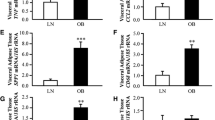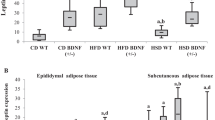Abstract
It has been reported that apelin functions as an adipokine, which has been associated to obesity and insulin resistance. The objective of this study was to analyze the apelin mRNA expression in white adipose tissue (WAT) from high-fat (Cafeteria) fed rats, in order to examine potential relationships with obesity markers and other related risk factors. Animals fed on the high-fat diet during 56 days increased their body weight, total body fat and WAT depots weights when compared to controls. Apelin subcutaneous mRNA expression was higher in the Cafeteria than in the Control fed group and this increase was partially reversed by dietary vitamin C supplementation. Statistically significant associations between subcutaneous apelin gene expression and almost all the studied variables were identified, being of special interest the correlations found with serum leptin (r = 0.517), liver malondialdehyde (MDA) levels (r = 0.477), and leptin, IRS-3 and IL-1ra retroperitoneal mRNA expression (r = 0.701; r = 0.692 and r = 0.561, respectively). These associations evidence a possible role for apelin in the excessive weight gain induced by high-fat feeding and increased adiposity, insulin-resistance, liver oxidative stress and inflammation.




Similar content being viewed by others
References
Tatemoto K, Hosoya M, Habata Y et al (1998) Isolation and characterization of a novel endogenous peptide ligand for the human APJ receptor. Biochem Biophys Res Commun 251:471–476
Lee DK, Cheng R, Nguyen T et al (2000) Characterization of apelin, the ligand for the APJ receptor. J Neurochem 74:34–41
Medhurst AD, Jennings CA, Robbins MJ et al (2003) Pharmacological and immunohistochemical characterization of the APJ receptor and its endogenous ligand apelin. J Neurochem 84:1162–1172
Cheng X, Cheng XS, Pang CC (2003) Venous dilator effect of apelin, an endogenous peptide ligand for the orphan APJ receptor, in conscious rats. Eur J Pharmacol 470:171–175
Reaux A, De Mota N, Skultetyova I et al (2001) Physiological role of a novel neuropeptide, apelin, and its receptor in the rat brain. J Neurochem 77:1085–1096
Taheri S, Murphy K, Cohen M et al (2002) The effects of centrally administered apelin-13 on food intake, water intake and pituitary hormone release in rats. Biochem Biophys Res Commun 291:1208–1212
Wang G, Anini Y, Wei W et al (2004) Apelin, a new enteric peptide: localization in the gastrointestinal tract, ontogeny, and stimulation of gastric cell proliferation and of cholecystokinin secretion. Endocrinology 145:1342–1348
O’Shea M, Hansen MJ, Tatemoto K et al (2003) Inhibitory effect of apelin-12 on nocturnal food intake in the rat. Nutr Neurosci 6:163–167
Boucher J, Masri B, Daviaud D et al (2005) Apelin, a newly identified adipokine up-regulated by insulin and obesity. Endocrinology 146:1764–1771
Sorhede Winzell M, Magnusson C, Ahren B (2005) The APJ receptor is expressed in pancreatic islets and its ligand, apelin, inhibits insulin secretion in mice. Regul Pept 131:12–17
Wei L, Hou X, Tatemoto K (2005) Regulation of apelin mRNA expression by insulin and glucocorticoids in mouse 3T3-L1 adipocytes. Regul Pept 132:27–32
Daviaud D, Boucher J, Gesta S et al (2006) TNF alpha up-regulates apelin expression in human and mouse adipose tissue. Faseb J 20:1528–1530
Kralisch S, Lossner U, Bluher M et al (2007) Growth hormone induces apelin mRNA expression and secretion in mouse 3T3-L1 adipocytes. Regul Pept 139:84–89
Berraondo B, Marti A, Duncan JS et al (2000) Up-regulation of muscle UCP2 gene expression by a new beta3-adrenoceptor agonist, trecadrine, in obese (cafeteria) rodents, but down-regulation in lean animals. Int J Obes Relat Metab Disord 24:156–163
Campion J, Martinez JA (2004) Ketoconazole, an antifungal agent, protects against adiposity induced by a cafeteria diet. Horm Metab Res 36:485–491
Lopez IP, Milagro FI, Marti A et al (2005) High-fat feeding period affects gene expression in rat white adipose tissue. Mol Cell Biochem 275:109–115
Milagro FI, Campion J, Martinez JA (2006) Weight gain induced by high-fat feeding involves increased liver oxidative stress. Obesity 14:1118–1123
Campion J, Milagro FI, Fernández D et al (2006) Differential gene expression and adiposity reduction induced by ascorbic acid supplementation in a cafeteria model of obesity. J Physiol Biochem 62:71–80
Margareto J, Aguado M, Oses-Prieto JA et al (2000) A new NPY-antagonist strongly stimulates apoptosis and lipolysis on white adipocytes in an obesity model. Life Sci 68:99–107
Matthews DR, Hosker JP, Rudenski AS et al (1985) Homeostasis model assessment: insulin resistance and beta-cell function from fasting plasma glucose and insulin concentrations in man. Diabetologia 28:412–419
Vandesompele J, De Preter K, Pattyn F et al (2002) Accurate normalization of real-time quantitative RT-PCR data by geometric averaging of multiple internal control genes. Genome Biol 3:research0034.1–research0034.11
Montague CT, Prins JB, Sanders L et al (1998) Depot-related gene expression in human subcutaneous and omental adipocytes. Diabetes 47:1384–1391
Villafuerte BC, Fine JB, Bai Y et al (2000) Expressions of leptin and insulin-like growth factor-I are highly correlated and region-specific in adipose tissue of growing rats. Obes Res 8:646–655
Heinonen MV, Purhonen AK, Miettinen P et al (2005) Apelin, orexin-A and leptin plasma levels in morbid obesity and effect of gastric banding. Regul Pept 130:7–13
Lambin S, van Bree R, Caluwaerts S et al (2007) Adipose tissue in offspring of Lepr(db/+) mice: early-life environment vs. genotype. Am J Physiol Endocrinol Metab 292:E262–E271
Marceau P, Biron S, Hould FS et al (1999) Liver pathology and the metabolic syndrome X in severe obesity. J Clin Endocrinol Metab 84:1513–1517
Day BW, Bergamini S, Tyurina YY et al (1998) Beta-Carotene. An antioxidant or a target of oxidative stress in cells? Subcell Biochem 30:209–217
Kleinz MJ, Davenport AP (2005) Emerging roles of apelin in biology and medicine. Pharmacol Ther 107:198–211
Duryee MJ, Willis MS, Freeman TL et al (2004) Mechanisms of alcohol liver damage: aldehydes, scavenger receptors, and autoimmunity. Front Biosci 9:3145–3155
Tatemoto K, Takayama K, Zou MX et al (2001) The novel peptide apelin lowers blood pressure via a nitric oxide-dependent mechanism. Regul Pept 99:87–92
Anai M, Funaki M, Ogihara T et al (1998) Altered expression levels and impaired steps in the pathway to phosphatidylinositol 3-kinase activation via insulin receptor substrates 1 and 2 in Zucker fatty rats. Diabetes 47:13–23
Lopez IP, Marti A, Milagro FI et al (2003) DNA microarray analysis of genes differentially expressed in diet-induced (cafeteria) obese rats. Obes Res 11:188–194
Perez-Echarri N, Perez-Matute P, Martinez JA et al (2005) Serum and gene expression levels of leptin and adiponectin in rats susceptible or resistant to diet-induced obesity. J Physiol Biochem 61:333–342
Somm E, Cettour-Rose P, Asensio C et al (2006) Interleukin-1 receptor antagonist is upregulated during diet-induced obesity and regulates insulin sensitivity in rodents. Diabetologia 49:387–393
Acknowledgements
The authors wish to thank to Línea Especial (LE/97) from the University of Navarra, Navarra Government funds from 2000, as well as to the Comunidad de Trabajo de los Pirineos CTP (Navarra) for financial support.
Author information
Authors and Affiliations
Corresponding author
Rights and permissions
About this article
Cite this article
García-Díaz, D., Campión, J., Milagro, F.I. et al. Adiposity dependent apelin gene expression: relationships with oxidative and inflammation markers. Mol Cell Biochem 305, 87–94 (2007). https://doi.org/10.1007/s11010-007-9531-5
Received:
Accepted:
Published:
Issue Date:
DOI: https://doi.org/10.1007/s11010-007-9531-5




